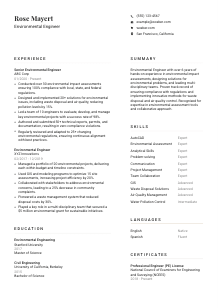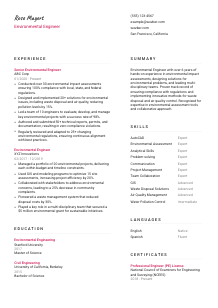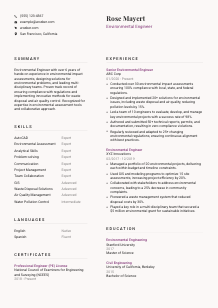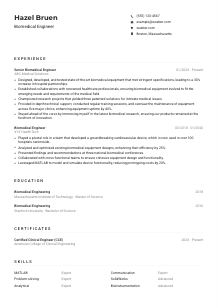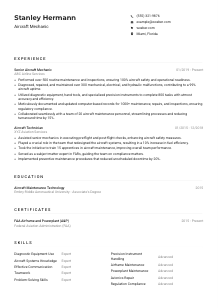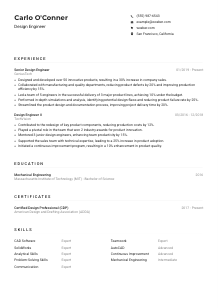Environmental Engineer Resume Example
Crafting eco-solutions, but your resume feels out of its element? Green up your profile with this Environmental Engineer resume example, cultivated using Wozber free resume builder. Discover how to integrate your sustainability skills with job criteria, paving a career path that's as clean and impactful as your projects.
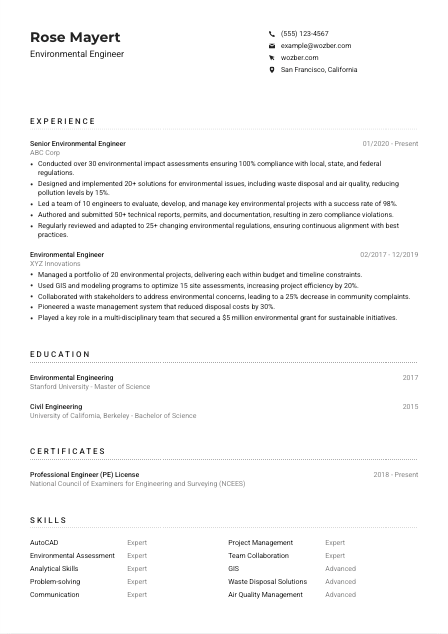
How to write an Environmental Engineer resume?
Embarking on the quest for an Environmental Engineer position? You're in the right place. This guide, powered by Wozber's free resume builder, is a treasure map to creating a resume that not only ticks all the boxes but does so with flair and precision. For Environmental Engineers, fine-tuning your resume to match both the rigor and detail of the field is essential.
Ready to transform your resume into a beacon of opportunity? Let's unearth the secrets to a resume that opens doors.
Personal Details
First impressions count, especially on your resume. The Personal Details section, while seemingly straightforward, is your introduction to potential employers. Let's explore how to perfect this section for an Environmental Engineer role, ensuring clarity, professionalism, and alignment with job requirements.
1. Name & Profession
Your name is more than a label; it's the title of your professional story. Use a clear, bold font to make it stand out. Directly underneath, align yourself with the role by stating "Environmental Engineer" to assert your professional identity right off the bat.
2. Essential Contact Information
Streamline your contact info by including only the essentials: a phone number (double-check for typos!) and a professional email address, ideally formatted as firstname.lastname@email.com. This simplicity ensures easy communication without clutter.
3. Address: Local Advantage
Given the job's requirement for San Francisco, California residency, prominently featuring your local address can be a passive yet powerful nudge, reassuring the employer of your logistical compatibility. It subtly tick boxes in terms of relocation concerns.
4. Web Presence
In today's interconnected world, a LinkedIn profile is often expected. Ensure it's not only included but also mirrors the professionalism of your resume. Regular updates and alignment between your resume and LinkedIn profile are crucial for consistency.
5. Privacy Respect
Skip adding personal details like age or marital status. Such information isn't just extraneous; it's a safeguard against potential bias. Keep the focus on your qualifications and fit for the role of an Environmental Engineer.
Takeaway
The Personal Details section sets the stage for your resume. By crafting it with thought and attention, you affirm your professionalism and strategic fit for the role. Consider it your resume's opening handshake: firm, professional, and poised to make a great first impression.





Experience
The Experience section is your resume's powerhouse, showcasing your professional journey and achievements. Here's how to shape it to resonate with Environmental Engineer roles, reflecting your expertise and alignment with the responsibilities and requirements outlined in the job description.
- Conducted over 30 environmental impact assessments ensuring 100% compliance with local, state, and federal regulations.
- Designed and implemented 20+ solutions for environmental issues, including waste disposal and air quality, reducing pollution levels by 15%.
- Led a team of 10 engineers to evaluate, develop, and manage key environmental projects with a success rate of 98%.
- Authored and submitted 50+ technical reports, permits, and documentation, resulting in zero compliance violations.
- Regularly reviewed and adapted to 25+ changing environmental regulations, ensuring continuous alignment with best practices.
- Managed a portfolio of 20 environmental projects, delivering each within budget and timeline constraints.
- Used GIS and modeling programs to optimize 15 site assessments, increasing project efficiency by 20%.
- Collaborated with stakeholders to address environmental concerns, leading to a 25% decrease in community complaints.
- Pioneered a waste management system that reduced disposal costs by 30%.
- Played a key role in a multi‑disciplinary team that secured a $5 million environmental grant for sustainable initiatives.
1. Dissect Job Requirements
Start with a deep dive into the job listing. This role calls for expertise in environmental assessments, developing solutions for environmental challenges, and a solid grounding in both project management and regulatory compliance. Highlighting experiences that speak to these areas is key.
2. Highlight Relevant Roles
Structure your experience starting with your most recent positions. For each, include your job title, company name, and tenure. Spotlight roles that directly pertain to environmental engineering, especially those involving environmental assessments and project management.
3. Quantify & Qualify Achievements
Numbers talk. Quantifying achievements, such as "Conducted over 30 environmental impact assessments" or "Led a team of 10 engineers," offers tangible proof of your capabilities and scope of experience. It's a persuasive way to demonstrate your impact and proficiency.
4. Map Accomplishments to Responsibilities
Your role in managing projects and aligning them with changing environmental regulations can be compellingly conveyed through accomplishments like "Regularly reviewed 25+ changing environmental regulations, ensuring continuous alignment." These statements showcase a proactive and knowledgeable approach, crucial for this role.
5. Relevance is King
While breadth of experience is valuable, relevance reigns supreme. Ensure that every point on your resume directly supports your candidacy for the Environmental Engineer role. Extraneous details might dilute the potency of your truly relevant achievements.
Takeaway
The Experience section is where your professional journey should shine brightest. It's an opportunity to showcase not just what you've done, but how what you've done prepares you for what you're aiming to do next. Tailor it with precision, and let your experience speak volumes.
Education
In Environmental Engineering, the solid foundation of your educational background is crucial. It's not just about meeting the criteria; it's about underscoring the rigor and relevance of your studies to the role. Let's fine-tune the Education section to highlight your fit.
1. Identify Key Requirements
The role requires a "Bachelor's degree in Environmental Engineering, Civil Engineering, or a related field." Present your educational credentials up front, ensuring they're squarely aligned with these stipulations.
2. Structure for Clarity
Maintain a crystal-clear structure: Include the degree title, field of study, institution, and graduation date. This layout not only makes information easily digestible but also allows for quick verification of your educational qualifications.
3. Degree Specificity
Match your degrees precisely to the job requirements. If you have a "Master of Science in Environmental Engineering" and a "Bachelor of Science in Civil Engineering," make these the stars of your Education section. It's a direct hit on the job's educational needs.
4. Relevant Coursework
If early in your career, or if the position is highly specialized, listing significant courses (e.g., environmental assessment techniques, GIS applications) can enrich your resume by showcasing focused expertise.
5. Additional Accolades
Did you graduate summa cum laude? Or perhaps you led a significant research project? These achievements can be intriguing, especially for early-career professionals. However, for more seasoned roles, they may serve as mere garnish to your main course of experience and expertise.
Takeaway
Transform your Education section from a basic checklist into a testament to your qualifications and dedication. Let it reflect the depth and breadth of your learning, tailored specifically to the demands of an Environmental Engineer role. It's more than history; it's your launchpad.
Certificates
Certificates are tangible markers of continuous learning and specialization. In the environmental engineering field, specific certifications can substantially boost your resume. Here's how to strategically select and present your certifications for maximum impact.
1. Zoom in on Job Requirements
The job posting specifies a "Valid Professional Engineer (PE) license in Environmental Engineering." This certificate isn't just optional; it's a central requirement. Ensure it's prominently featured, with current validity dates.
2. Prioritize Pertinence
Less is often more. Choose to display certifications that directly tie into the job requirements or those that elevate your expertise in areas like GIS or AutoCAD. This focus ensures the hiring manager spots your most relevant qualifications instantly.
3. Transparency with Dates
For certificates with expiration dates or those obtained recently, include these dates. It portrays you as up-to-date and compliant with current standards and practices in environmental engineering.
4. Commit to Continual Learning
The fields of engineering and environmental science evolve swiftly. Stay caught up with trends and update your certificates regularly. This dedication to professional growth is a strong selling point for potential employers.
Takeaway
Certificates are your resume's badges of honor. They underline your dedication to staying ahead in your field. Selectively showcase those that bolster your candidacy for an Environmental Engineer position, ensuring they're as current as possible to reflect your active engagement with the profession.
Skills
For an Environmental Engineer, the Skills section is your toolkit display. It's essential to itemize your technical prowess alongside soft skills, painting a complete picture of your capabilities. Let's break down how to perfect this section for your target role.
1. Decode Explicit & Implicit Skills
Extract both the stated and suggested skills from the job description. Skills like "Proficient in environmental assessment tools and software" directly match the job's call for AutoCAD, GIS, and modeling programs expertise.
2. Showcase Matching Skills
Prioritize skills that are a direct reflection of the job requirements. If "Analytical Skills" and "Problem-solving" are listed as your top proficiencies, you're directly addressing the employer's needs.
3. Organization & Precision
Order your skills from most to least relevant for the role, creating a compelling argument for your candidacy right off the bat. Avoid cluttering with unrelated skills, opting for quality and relevance over quantity.
Takeaway
Your Skills section isn't just a list; it's a strategic display of your professional arsenal tailored to meet the demands of an Environmental Engineer role. Focus on relevance and significance, letting each skill you list act as a pillar supporting your candidacy.
Languages
In today's global workplace, language skills can significantly bolster your resume. Even for roles not explicitly requiring multilingual abilities, showcasing linguistic versatility can be a plus. Here's how to tailor this section for an Environmental Engineer role.
1. Review Language Requirements
The job description emphasizes "Effective oral and written English communication skills." Ensure English proficiency is front and center, labeled as 'Native' or 'Fluent' to meet this non-negotiable requirement.
2. Additional Languages
Following the essential, list any additional languages you're proficient in. This depth can offer an edge, demonstrating versatility and readiness for projects or teams with global ties.
3. Honest Proficiency Levels
Use standardized terms like 'Native,' 'Fluent,' 'Intermediate,' and 'Basic' to describe your proficiency. Clear communication about your language skills sets accurate expectations.
4. Global Perspective
For roles with potential international interaction, additional languages signal your ability to navigate diverse settings. Even if not a primary requirement, it's a valuable trait showing that you're prepared for broader horizons.
5. Continuous Improvement
Language skills, like all skills, evolve. Engage in ongoing learning to improve your linguistic abilities, preparing you for opportunities that require or benefit from multilingual communication.
Takeaway
Leveraging your language abilities can subtly differentiate your resume, underscoring a capability for clear communication and adaptability in a global context. Position it as complementary to your primary qualifications, enhancing your overall candidacy for the Environmental Engineer role.
Summary
The Summary section is your chance to encapsulate your professional identity and value proposition. It sets the tone, offering a bird's eye view of why you're the right fit for the Environmental Engineer position. Let's explore how to craft a summary that resonates.
1. Capture the Job Essence
Internalize the job posting, absorbing the primary requirements and responsibilities. This role seeks an individual adept in environmental impact assessments, project management, and regulatory compliance – weave these elements into your summary.
2. Professional Snapshot
Begin with a compelling introduction that highlights your years of experience, your professional designation as an "Environmental Engineer," and a brief mention of your area of expertise or a notable achievement.
3. Distill Key Qualifications
Highlight your expertise in environmental assessment tools, mention your problem-solving proficiency, and underscore your successful project management experience. This specificity links your unique strengths directly to the job's requirements.
4. Brevity & Impact
Though it's tempting to cram in every detail, remember the power of brevity. A concise, impactful summary not only captivates attention but also encourages the hiring manager to delve deeper into your resume.
Takeaway
Consider your Summary the trailer to your professional saga. It should entice, inform, and compel the hiring manager to explore more. Tailor it to sing in harmony with the Environmental Engineer role, making it impossible for the hiring manager not to want to read on.
Launching Your Environmental Engineer Journey
Congratulations! Armed with a fine-tuned, ATS-compliant resume, your journey towards landing that dream Environmental Engineer role is well underway. Every section of your resume has been crafted to highlight your qualifications and readiness for the challenges ahead. Remember, the Wozber free resume builder is here to simplify this process, providing ATS-friendly resume templates and an ATS resume scanner to ensure your resume not only meets but exceeds expectations.
The path is clear, and the blueprint is yours. Now, go forth – the world awaits your contributions.

- Bachelor's degree in Environmental Engineering, Civil Engineering or a related field.
- Minimum of 5 years of experience in environmental engineering or related roles.
- Proficient in using environmental assessment tools and software such as AutoCAD, GIS, and modeling programs.
- Strong analytical, problem-solving, and communication skills.
- Valid Professional Engineer (PE) license in Environmental Engineering.
- Effective oral and written English communication skills required.
- Must be located in San Francisco, CA.
- Conduct environmental impact assessments and site investigations to ensure compliance with local, state, and federal regulations.
- Design and implement solutions for environmental problems, such as waste disposal, water pollution control, and air quality management.
- Collaborate with multi-disciplinary teams to evaluate, develop, and manage environmental projects and programs.
- Prepare technical reports, permits, and documentation related to environmental projects.
- Stay updated on changing environmental regulations and best practices, and recommend necessary modifications to projects or operations to ensure compliance.





